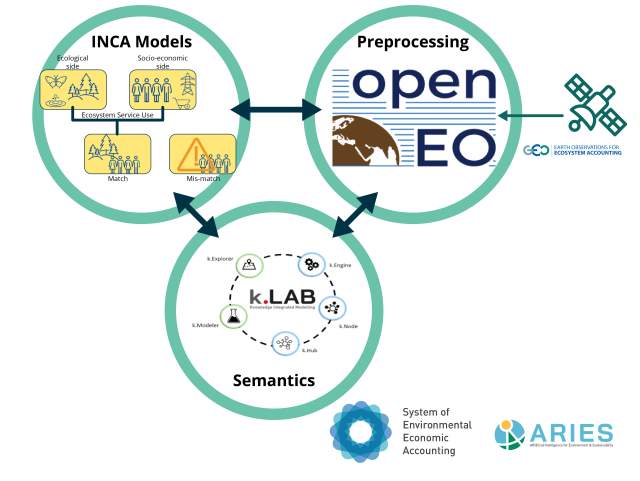Ecosystem accounting
The United Nations Statistical Commission has recently released an integrated and comprehensive statistical framework, named System of Environmental Economic Accounting (SEEA) Ecosystem Accounting (EA). This new framework organizes data about habitats and landscapes, measures the ecosystem services, tracks changes in ecosystem assets, and links this information to economic and other human activity.
Ecosystem accounts are inherently spatial accounts, with the implication that they strongly depend on the availability of spatially explicit datasets. The emerge of dense EO data streams at appropriate scales combined with the advances in digital technologies offer unprecedent opportunities for countries to efficiently monitor the extent and condition of their ecosystems, determine ecosystem services and implement their ecosystem accounting. However, the use of EO data in ecosystem assessment and accounting is limited due to a number of conceptual and technical challenges.
PEOPLE-EA Objectives
The Pioneering Earth Observation Applications for the Environment - Ecosystem Accounting (PEOPLE-EA) project, funded by the European Space Agency, studies the relevance of Earth observations for SEEA EA and demonstrates its use for terrestrial and freshwater ecosystems through involvement of Early Adopters in Europe.

Main objectives:
- Review and describe the added value of integrating Earth Observation data for ecosystem accounting in terrestrial and freshwater ecosystems, expressed in physical terms for ecosystem extent, condition and ecosystem services.
- Co-develop (pioneer and test) innovative high-quality EO-based ecosystem account models according to the FAIR principle following an agile method.
- Showcase and validate a number of selected demonstrators to prove the value of integrating EO in national ecosystem accounting in a regular and consistent manner through the appliance of a cloud-based tool using open standardized interfaces
- Contribute to the international collaborative efforts to advance the use of EO in ecosystem accounting and support countries developing their national ecosystem accounts.
- Prepare a future outlook (R&D roadmap) to further scale-up the use of EO in ecosystem accounting.
PEOPLE-EA Architecture
To ease the generation of EO-based accounts by statistical offices, PEOPLE-EA integrates three state-of-art technologies through cloud platforms and keep Europe in a leading position in ecosystem accounting at biophysical level.
(figures)
- The INCA project has developed ecosystem service models based on an approach fully compliant with the SEEA EA to support European Member States in reporting ecosystem accounts.
- OPENEO develops an open application programming interface (API) that connects to several clients (Python, R, JavaScript) to perform data operations on big Earth Observation stored in the cloud, and used as an interface to generate Account Ready Data (AccoRD) stacks for the accounting models.
- k.LAB is a software platform designed to integrate models via use of well-defined scientific concepts and used as an Artificial Intelligence (AI) tool for rapid natural capital accounting (ARIES for SEEA Explorer)


